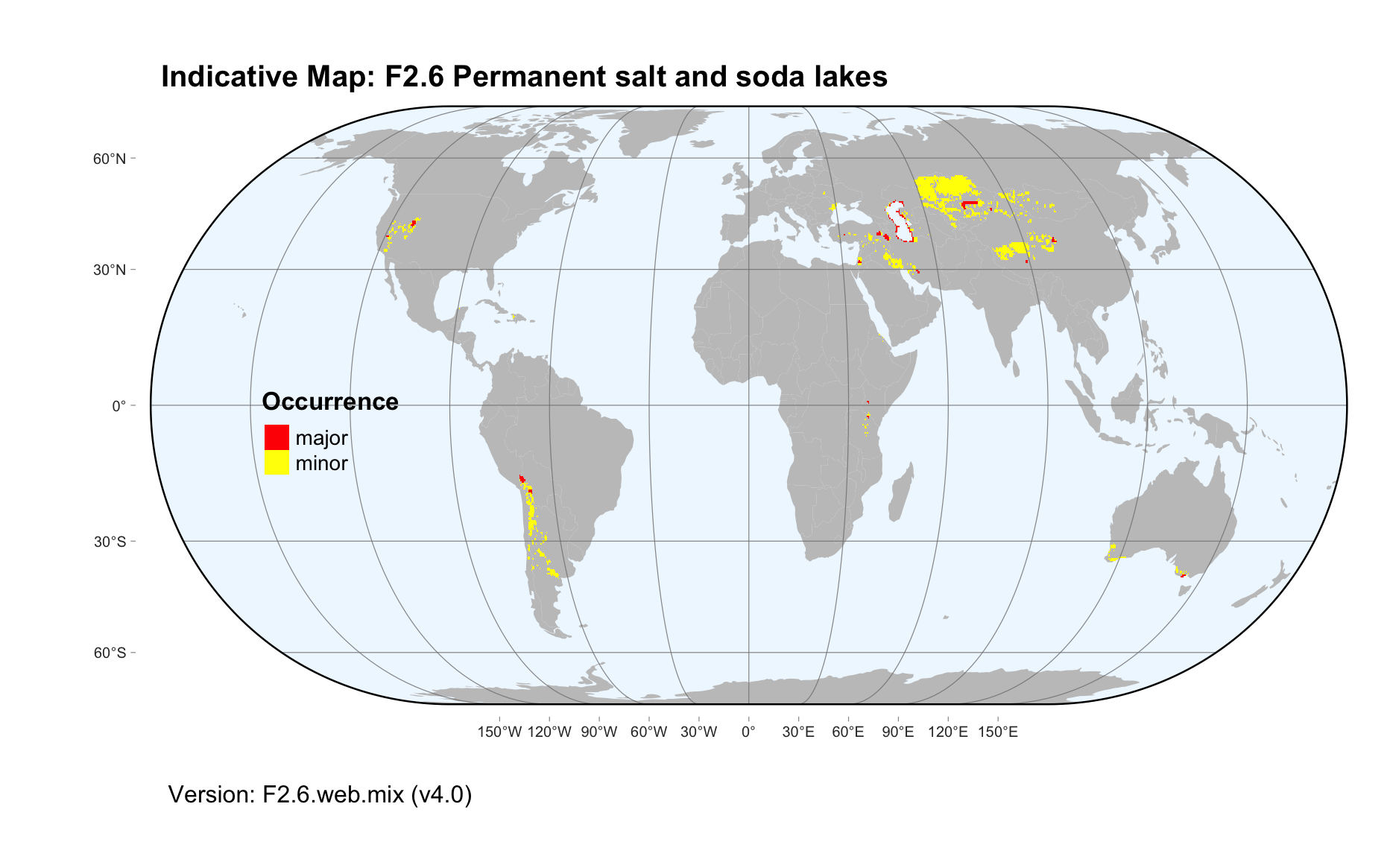Global ecosystem typology
Alternative site for the Global ecosystem typology with additional information for ecosystem profiles and indicative maps.
This site is maintained by jrfep
F2.6 Permanent salt and soda lakes
Biome: F2. Lakes biome
Contributors:
(texts)
These lakes are usually large and shallow in semi-arid regions, with high concentrations of salts, mediated by inflows of water. Their productivity from growth of algae and plants can support large numbers, but low diversity of organisms equipped with tolerance to high salinity and other solutes. They have relatively simple foodwebs, with high numbers of microbes and plankton, crustaceans, insect larvae, fish and specialised waterbirds such as flamingos.
Key Features
Permanent waterbodies with high inorganic solute concentrations (particularly sodium), supporting simple trophic networks, including cyanobacteria and algae, invertebrates and specialist birds.
Overview of distribution
Mostly in semi-arid regions of Africa, southern Australia, Eurasia, Europe and western North and South America.
Profile versions
- v1.0 (2020-01-20): RT Kingsford; DA Keith
- v2.0 (2020-05-24): RT Kingsford; JT Hollibaugh; B Robson; R Harper; DA Keith
- v2.01 ():
- v2.1 (2022-04-06): RT Kingsford; JT Hollibaugh; B Robson; R Harper; DA Keith Full profile available at official site
Main references
Selected references for this functional group:
Humayoun SB, Bano N, Hollibaugh JT (2003) Depth distribution of microbial diversity in Mono Lake, a meromictic soda lake in California Applied and environmental microbiology 69:1030-1042 DOI:10.1128/aem.69.2.1030-1042.2003
Williams WD (1998) Salinity as a determinant of the structure of biological communities in salt lakes Hydrobiologia 381:191-201
Boros E, Kolpakova M (2018) A review of the defining chemical properties of soda lakes and pans: An assessment on a large geographic scale of Eurasian inland saline surface waters PLoSONE 13(8):e0202205
Diagrammatic assembly model

Maps
Maps are indicative of global distribution patterns are not intended to represent fine-scale patterns. The maps show areas of the world containing major (coloured red) or minor occurrences (coloured yellow) of each ecosystem functional group. See general notes on maps.
There are 2 alternative versions of the indicative map for this functional group, please compare description and sources below.
F2.6.IM.mix_v4.0
Datasets
- FEOW-2008
- HydroLAKES-1.0
- CRU-TS-v4
- Saline-lake-list
Map references
Abell R, Thieme ML, Revenga C, Bryer M, Kottelat M, Bogutskaya N, Coad B, Mandrak N, Contreras Balderas S, Bussing W, Stiassny MLJ, Skelton P, Allen GR, Unmack P, Naseka A, Ng R, Sindorf N, Robertson J, Armijo E, Higgins JV, Heibel TJ, Wikramanayake E, Olson D, López HL, Reis RE, Lundberg JG, Sabaj Pérez MH, Petry P (2008) Freshwater ecoregions of the world: A new map of biogeographic units for freshwater biodiversity conservation, BioScience 58: 403–414. DOI:10.1641/B580507
Messager, M.L., Lehner, B., Grill, G., Nedeva, I., Schmitt, O. (2016) Estimating the volume and age of water stored in global lakes using a geo-statistical approach Nature Communications 13603 DOI:10.1038/ncomms13603
Harris, I., Jones, P.D., Osborn, T.J. and Lister, D.H. (2014), Updated high-resolution grids of monthly climatic observations - the CRU TS3.10 Dataset. International Journal of Climatology 34, 623-642 doi:10.1002/joc.3711 Revised appendix
Wurtsbaugh, W., Miller, C., Null, S. et al. Decline of the world’s saline lakes. Nature Geoscience 10, 816–821 (2017). 10.1038/ngeo3052
F2.6.web.mix_v4.0

Datasets
- HydroLAKES-1.0
- Saline-lake-list
- CRU-TS-v4
- FEOW-2008
Map references
Messager, M.L., Lehner, B., Grill, G., Nedeva, I., Schmitt, O. (2016) Estimating the volume and age of water stored in global lakes using a geo-statistical approach Nature Communications 13603 DOI:10.1038/ncomms13603
Wurtsbaugh, W., Miller, C., Null, S. et al. Decline of the world’s saline lakes. Nature Geoscience 10, 816–821 (2017). 10.1038/ngeo3052
Harris, I., Jones, P.D., Osborn, T.J. and Lister, D.H. (2014), Updated high-resolution grids of monthly climatic observations - the CRU TS3.10 Dataset. International Journal of Climatology 34, 623-642 doi:10.1002/joc.3711 Revised appendix
Abell R, Thieme ML, Revenga C, Bryer M, Kottelat M, Bogutskaya N, Coad B, Mandrak N, Contreras Balderas S, Bussing W, Stiassny MLJ, Skelton P, Allen GR, Unmack P, Naseka A, Ng R, Sindorf N, Robertson J, Armijo E, Higgins JV, Heibel TJ, Wikramanayake E, Olson D, López HL, Reis RE, Lundberg JG, Sabaj Pérez MH, Petry P (2008) Freshwater ecoregions of the world: A new map of biogeographic units for freshwater biodiversity conservation, BioScience 58: 403–414. DOI:10.1641/B580507
Check: the Glossary / Profile structure / the public document